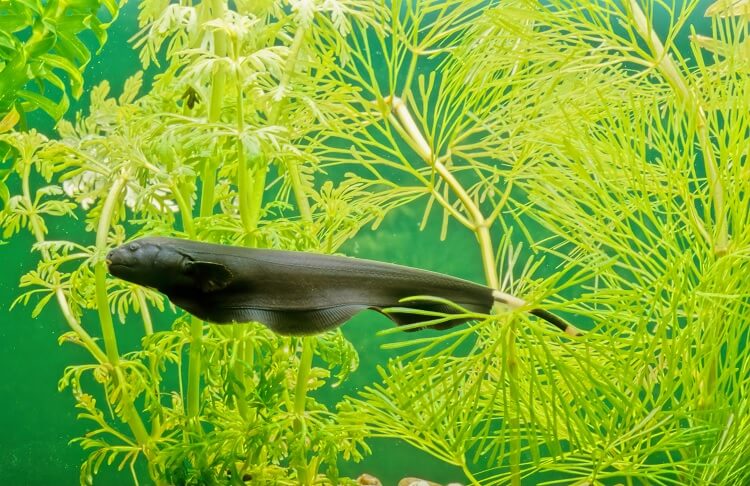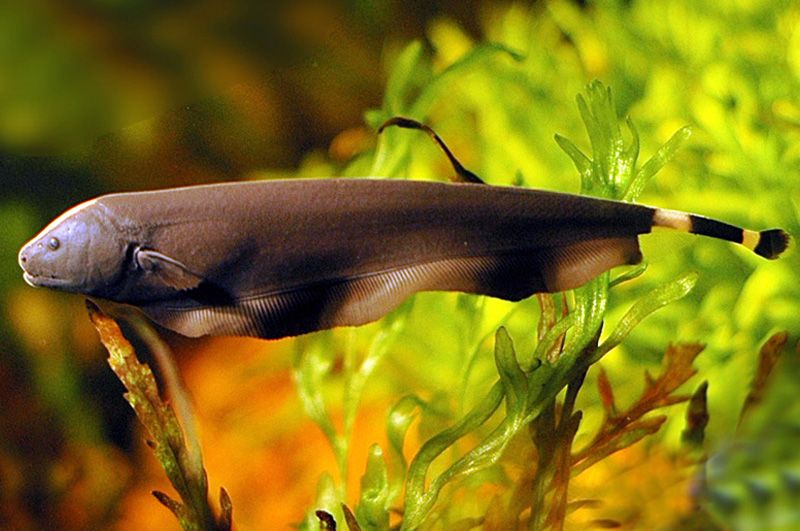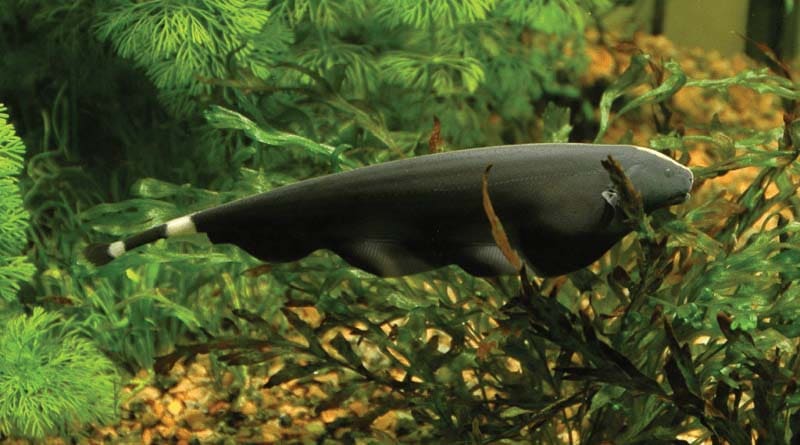Black ghost knifefish is unique and special for freshwater fish. They might look a bit scary at a glance, but once you know them, prepare to be amazed.
Unlike many other colorful tropical freshwater fish, the black ghost doesn’t look very festive. Their body has a beautiful velvety black-colored skin with some white rings around their tails. What makes them different is their long pectoral fin that flows gracefully as they swim.
In contrast to their intimidating look, the black ghost is actually peaceful and gentle. They love to mind their own business and can be tank mates to some species.
There is an interesting story about how the black ghost got their current name. This species is originally from rivers in South American areas. It is believed by the locals living around the Amazonian jungle that the ghosts of the dead live inside the fish.
That makes the black ghost sounds more interesting, right? You can get to know about this species better if you keep reading. And maybe you’ll get interested and ended up getting one.
Table of Contents
Black Ghost Knifefish Species Overview
| Scientific name: | Apteronotus albifrons |
| Family: | Apteronotidae |
| Origin: | South America |
| Care Level: | Intermediate |
| Diet: | Carnivore |
| Color: | Black body with 2 white rings on the tail |
| Size: | Up to 20 inches |
| Life expectancy: | 10 to 15 years |
| Temperament: | Semi-aggressive |
| Minimum tank size: | 100 gallons |
| Temperature: | 73 – 82°F (22 – 28 °C) |
| pH level: | 6.0 – 8.0 |
| Breeding: | Egglayer |
Black Ghost Knifefish Habitat
The black ghost knife fish is endemic to some regions in South America. They are widely spread across Amazon and its tributaries.
They can be found in a large portion of South American tropical freshwater in Brazil, Ecuador, Paraguay, Peru, and Venezuela. It’s more likely to spot them along the Parana and Paraguay rivers since their spread is more concentrated around these areas.
In the wild, the black ghost inhabits small streams or rivers with moderate currents and sandy bottoms. They prefer to stay in densely vegetated areas with plenty of crannies and corners. Hiding places are necessary for them since they are nocturnal and will likely avoid sunlight during the day.
Appearance & Characteristics

This stunning fish has a rather unusual look compared to other freshwater fish.
First of all, there’s not much to talk about its coloration. Their whole body is beautifully covered in jet black-colored skin with two small white rings around their tail. You can also see a white stripe along their nose bridge. And that’s basically it.
Although the color is pretty plain, the black ghost has other features to pay attention to. Their bodies are long, flat, and slender that gradually become thinner towards the tail. And the interesting part is, they have no caudal and dorsal fins!
In addition, this type of knife fish is scaleless. That makes them more sensitive when it comes to water conditions and diseases. You will need to put some effort into changing the water and check the quality.
They do have a long pectoral fin that is stretched from their belly all the way to their tail. Since these velvety blackfish do not have caudal and dorsal fins, they can only use the pectoral fin to manage their movement.
When the black knife swims, you can see their fin flowing gracefully as they roam around slowly.
Fun fact about this magical fish creature, they can produce electricity and receive electrical signals. However, it’s very gentle that they can’t sting you. They only use it to detect foods that are hidden and hard to find.
Size & Lifespan
Some false rumor says that the black ghost fish will grow according to their tank size has been spreading among aquarists. This is not true at all! The maximum size of the black knife fish is 20 inches when reaching adulthood. And they will not adjust to your smaller tank size.
Besides their length body, the black ghost also has quite a long lifespan. Most of the time, you can have them around for about 10 years. But if you keep them in optimum condition, they can reach the age of 15 years.
Even though it also depends on genetics, good water conditions and a balanced diet play roles in their thriving.
Typical Behavior
The black ghost knifefish is famous for being gentle and timid when first introduced to the aquarium. But once they feel comfortable and familiar with the environment, they will show themselves more.
However, you will only see them being active after the sun is down since they are nocturnal. You can mostly see them swimming near the substrate on the bottom of the tank. Slowly and gracefully, as they also try to feed.
This doesn’t necessarily mean that you can only feed the black knifefish at night. You can train them to get up during the feeding time like any other fish if you kept them in a community tank.
The only thing you need to do is be consistent with the time. This will help to make a habit for your knife fish.
Generally, the black ghost is tranquil and will only mind their own business. But if housed with other knifefish or smaller fish, you may see their aggressiveness.
Although they prefer to be in their own company, you can give them tank companions too. The golden rules are all the residents are peaceful fish and have plenty of space in the tank.
Tank Requirements
The black ghost knifefish indeed not for beginner aquarists since their size is quite massive and they have a tendency to become a little bit aggressive. This certainly requires a large tank and perfect setup, especially if you want to keep them with another fish companion.
Speaking of tank requirements, of course all types of fish included the black ghost will thrive well if we can mimic their natural habitat into the aquarium. And this is our setup recommendation to keep your first knife fish.
Tank size & setup
As it has been mentioned earlier, this knifefish can be huge. Therefore, a fairly large tank is required.
If you’re planning to house the black ghost knifefish, you need to provide at least a 100-gallon tank. The size needs to be adjusted to a bigger one if you keep them along with other species.
As for the setup, you cannot give or expose them to high intensity of brightness. The black ghost knives are nocturnal. In the wild, they like to hide away to avoid sunlight. You can mimic their natural habitat by placing many plants and decorations.
Speaking of decorations, it’s better to set your tank with smooth-surfaced decors to prevents the black ghost from getting injured. Keep in mind that they do not have scales and so need extra protection. In addition, you can put sandy gravel, which is also smooth, to fill your tank in.
Water parameters
Making sure the water condition as stable as possible and always in good quality is necessary for every fishkeeping journey.
As for the black ghost, water temperature between 73 – 82°F with a pH ranging from 6.0 to 8.0 is the golden range. For the hardness level, you can keep it between 5 – 19 dGH.
To maintain these water parameters, you need to change about 40% of the water every week. You can also get a UV sterilizer to help to keep the water clean from bacteria and diseases.
Decorations & Plants

This is the part where you can get creative. You can decorate your tank with whatever plants or decors, as long as you leave enough space for the Knifesfish to swim around.
But there’s one thing you always need to remember while decorating. The black ghost knives do not have scales, and so they are more fragile than scaled fish.
If you decide to put some rocks or caves (which are great shelters), make sure the surfaces are smooth enough.
As for the plants, you can just put any kind of it. The black ghost knifefish are carnivores, so they’ll never chewing the plants. Some driftwoods will also work perfectly.
Black Ghost Knifefish Tank Mates
Generally, the black ghosts are peaceful and possible to keep in a community tank. But before that, there are two things you need to take into account. First, this knifefish can grow pretty big. Second, they are predators.
If you wish to give the knife fish tank companions, make sure they are of similar size and behavior. Some freshwater fish that might be compatible with the black ghost knife fish are:
- Corydoras
- Angelfish
- Rainbowfish
- Peaceful Cichlids
- Large Swordtails
It will not be the best decision to keep the knifefish with their own species. It will trigger their aggressive side, which you don’t want to see from a peaceful fish. So it’s better to keep them with any other fish species.
Other than that, you also cannot house your black ghost knifefish with smaller fish or other species as they will see them as prey. Some species you may need to avoid being put together with the knifefish are:
- Barbs
- Rasboras
- Small tetras
- Guppies
- Shrimps and snails
Above are merely some suggestions. If you want to try to keep many other different fish with your Knifefish, nothing can stop you. However, it’s best to consult it first with the expert.
Diet and Feeding
Naturally, the black ghosts are carnivorous and predators. In their natural habitat, they eat worms, small fish, or mosquito larvae. Even in aquariums, they will stay true to their nature.
Therefore, you will have to feed them live or frozen foods like bloodworms, blackworms, and brine shrimp. Some people also give them Daphnia, krill, tubifex, and even crickets.
The best time to feed the black ghost knife fish is at night since they are nocturnal and more active around this time. But you can also feed them during the daylight, although it may take some time for them to adapt.
How many times do you need to feed them? Just a few times a day. Maybe twice or three times with an adequate amount. If you see some leftovers, you need to decrease the amount of food next time you feed them.
Overfeeding will lead them to an unhealthy diet, and the uneaten foods will contaminate the water.
Genders
Distinguishing the male and the female knife fish can be tricky. But if you have sharp eyesight, you may notice some differences.
The males usually have a fat lump on the back of their heads, while the females have a rounder belly.
Other than that, it is said that the female black ghosts emit and receive more electric fields than the males. It results in them being more responsive to food.
But all in all, it’s still pretty tricky to tell both genders apart.
Breeding Black Ghost Knifefish
It’s a rather complicated topic to get upon. Some sources say that you can breed the black ghost knifefish in your home aquarium (although not recommended), while some others say the opposite.
Breeding the knife fish is more commonly done by commercial aquarists. Many of them do it in Indonesia, but their secret to successful breeding remains unknown.
If you are confident enough and want to attempt to breed your black ghost knifefish, we can give you some information about the requirements.
Breeding Tank Requirements
First, you will need an enormous tank. We’re talking about a 100-gallon tank (or more than 200 even). The black ghost knififish is not a small fish species, and housing two of them means you need a very spacious area in the tank.
Second, a pair of mature and compatible black ghost knifefish. This fish species is considered mature and ready to mate once they reach the age of 1.5 years.
But just having two black ghosts of the same age doesn’t necessarily mean that they are compatible. Some reports say that finding a perfect mating partner for the knife fish is the most challenging part of the breeding process.
Next, you need lots of plants, large pebbles, and smooth-surfaced decorations. Basically, you need to provide sufficient hiding spots into the breeding tank so your black ghost fish can lay their eggs.
Water Parameters for Breeding
Another requirement to successfully breed knifefish is the right water dan tank condition. You have to place your tank in a dark, peaceful place with little disturbance. That will prevent the mother from getting stressed and feeling threatened.
As for the water conditions, soft water with a temperature of 80°F (27°C) is considered optimum for breeding. To keep this parameter consistent, you need to change 25% – 50% of the water every two days.
If your knife fish has successfully spawned, make sure to secure the eggs (move them to another tank, perhaps) since the parents will likely eat their own eggs.
Potential Diseases
The black ghost knife’s body is not armored by scales, which makes them more prone to skin diseases than other fish. Even though they are sturdy, there are still possibilities of them catching illness.
Luckily, there are no specific diseases that can only attack the black ghost knife fish. But like many other freshwater fish species, Ich is something you might need to anticipate.
Ich is a common skin disease that is caused by parasites. This condition is recognizable by the emerging white spots on the fish’s body. You may also notice a change in their behavior.
If it happens, you can treat the Ich by changing the water since the parasite lives in it. You can then raise the temperature to around 80°F or use over-the-counter drugs.
Another common illness you can watch out for is skin flukes. Flukes are tiny parasites that embed themselves in the fish and make them the host.
Common symptoms of this condition are loss of appetite, redness on the skin, and itchiness. If you see your fish rub their bodies against the tank decor, this might also be a symptom.
Fortunately, it’s not too difficult to cure the disease. You need to adjust and correct the water parameters or use medication as well.
Closing
The black ghost knifefish is undeniably stunning, and they don’t demand much. No matter if you just started or you are already an expert, this species is an interesting pick.
The black knives don’t require any special care, except about being picky for the smooth-surfaced decorations, but that should not count. As for feeding, you just need to give them meat-based food.
There’s one more thing to remember. You can’t underestimate their size. They can grow big, so if you want to keep them, make sure you have at least a 100-gallon tank. That ensures that they have enough room for them to roam.
Now that you already have all the necessary information, you seem to be ready to house a black ghost knifefish!






